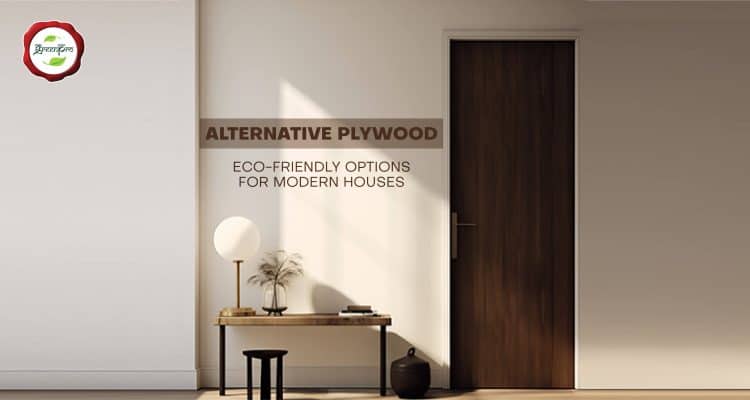Plywood has been the material for construction purposes for many decades, first because it was strong, rather cheap, and quite versatile. However, today, on account of the growing concern with the felling of trees and environmental effect, people are demanding eco-friendly substitutes to plywood for the purpose of the construction of new houses. In this blog, we are discussing some of the most promising alternatives, their benefits and shortcomings, along with limitations for application in various uses.
Bamboo
One of the quick renewable resources is bamboo.This specific resource can be considered an environmentally friendly, multipurpose substitute for plywood and possesses similar characteristics such as strength-to-weight ratio as steel when used as a building element. Moreover, bamboo has natural resistance against insects and fungus growth that ensure its longevity irrespective of different weather conditions.
Benefits of Bamboo
Growth: It reduces the environmental impact of harvesting a material.
Strength-to-weight ratio is high: It is best suited for structural applications such as beams, columns, and flooring.
Natural insulation: The structural cellular structure of bamboo provides great insulation; hence less energy is required to maintain it.
Aesthetic appeal: The grain patterns of bamboo and warm tints add a natural and classy feature to the home.
Disadvantages of Bamboo
Limited availability: Although bamboo happens to be very readily available in some regions, it might prove more challenging to source in others.
The bamboo must be pretreated so that it does not warp and split, and this also increases the price.
Cross-Laminated Timber (CLT)
CLT is a composite wood material that involves solid lumber pieces stuck together in perpendicular patterns. The structure makes the product robust and stable and applicable for walls, floors, and roofs. CLT is typically produced from sustainably sourced timber.
Benefits of CLT
High strength and stiffness: CLT is very strong and can support load-bearing structures.
Better fire resistance: CLT offers a higher number of resistance ratings than conventional wood-framed construction.
Shorter construction time: Off-site prefabrication of CLT panels saves a huge amount of on-site construction time.
Acoustic improvement: CLT can be used to significantly improve sound insulation in buildings
Drawbacks
Pricier than conventional wood-framed construction, thus highly costly.
CLT may not be available in every region.
Environmental issues: Much green building material, of course, is timber, from sustainably sourced suppliers. Even so, of course, with large-scale tree harvesting in mind, the cost of construction to the environment itself raises concerns.
Straw bales
Straw bales are large compressed bundles of straw that are use in building construction. Straw bale, straw bale construction – this term refers to a method of building, which uses bales of straw (usually from wheat, rice, rye or oat straw) as structural components. In the USA, by agricultural workers who were creating barbecues sides framed with compressed bales, this was among the first instances of an attempt to build a load-bearing structure such as this. And they still exist! These bales serve as the foundation of the track, which is covered with an outer waterproof tarp to protect the bales from rain, sunlight, and snow. Sheila baled insulation helps to contain heat within the building and also minimizes energy usage for heating.
Straw Bale Construction Advantages
Best thermal insulation: It reduces the energy consumption hence reduce fuel cost in heating and cooling.
The use of straw has a low energy capital: Straw is one such material that does not needs a lot of energy consumed, thus eases the overall environmental burden of construction.
Sustainable Building There is a natural building material called Straw which is produced using the waste materials that can grow every year and decay in time.
On the other hand, because straw bales can take in and let out moisture, they can help lower the indoor relative humidity and thus the chances of mold forming, as well as possibly cleansing the air of particular indoor pollutants.
Disadvantages of Straw Bale Construction:
Straw bales may be not available in every region at a moment’s notice.
Specialized knowledge expert: Straw bale construction requires specific knowledge and experience.
It invites insects, unless proper treatment is applied when straw bales are used
Recycled Wood Products
Recycled timber and manufactured wood composites belonging to the category of reused wood goods are utilized as floorings, beams, or other supporting components. They are a more eco-friendly choice than raw timber.
Benefits of Recycled Wood Products:
Reduced impact on the environment: The need for fresh timber is lessened because recycling wood helps to minimize deforestation.
The reclaimed timber has an appearance and history that gives a character and uniqueness to a home.
Many recycled wood products are very durable and can endure generations.
Disadvantages of Recycled Wood Products:
There is low availability because reclaimed timber is sometimes difficult to source in large quantities.
Quality: The quality of recycled wood differs.It is expensive. Reclaimed timber is indeed more expensive than virgin wood.
For each homeowner, selecting building materials is one of the most important decisions.
Choosing some sustainable alternatives to plywood, including bamboo, CLT, straw bales or recycled wood products helps in getting a more environmentally friendly and sustainable built environment. Each option has pros and cons thus it is important that you assess your own needs as well as preferences before making any choices whatsoever.
